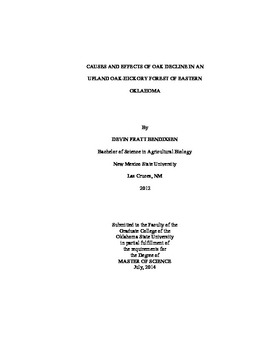| dc.contributor.advisor | Hallgren, Stephen W. | |
| dc.contributor.author | Bendixsen, Devin Pratt | |
| dc.date.accessioned | 2015-06-17T20:04:51Z | |
| dc.date.available | 2015-06-17T20:04:51Z | |
| dc.date.issued | 2014-07-01 | |
| dc.identifier.uri | https://hdl.handle.net/11244/14725 | |
| dc.description.abstract | Oak decline has greatly altered the structure and composition of temperate hardwood forests and is caused by a complex interaction of environmental stresses and pests. These stresses can be biotic or abiotic and can be diverse, ranging from insect infestation to drought. Oak decline affected Okmulgee Game Management Area (OGMA) in eastern Oklahoma between 2007 and 2008. The purpose of this study was to determine the causes and ecological effects of oak decline in a xeric oak-hickory forest of eastern Oklahoma.This study found that the oak decline occurrence in OGMA was associated with a complex of stress factors including, distance to water, slope, elevation, aspect, drought, false spring and three plant pathogens. Total canopy mortality due to oak decline affected understory species composition, species richness and biomass. Graminoid cover increased 2-4 fold, species richness increased 60-80%, and biomass increased 4-10 fold. Forb species richness increased 1.7-2.0 fold. Oak decline had an impact on forest composition and structure. Live basal area was greatly reduced in affected areas and mortality affected all size categories except stems less than 5 cm dbh. Oak decline was associated with a shift in the relative basal area and caused an increase in the sprouts of subordinate species. Oak decline did not, however, affect the species composition of stem density. Sprout density was not affected, but sprout height doubled in decline areas. Oak decline also was associated with an increase in true seedlings of oak species in the understoryAlthough the catastrophic disturbance over large areas caused by oak decline is rare in the Cross Timbers, it may be a mechanism for maintaining species diversity in this vegetation ecotone between eastern forests and western grasslands. Therefore, this study concluded that, given the evidence found and the current fire regime of the study area it is difficult to accurately predict the future of these stands. Due to the frequent fires the areas affected by oak decline possibly might persist as an oak savanna. However, due to high amounts of regeneration, the areas might possibly return to a closed canopy oak-hickory forest. | |
| dc.format | application/pdf | |
| dc.language | en_US | |
| dc.publisher | Oklahoma State University | |
| dc.rights | Copyright is held by the author who has granted the Oklahoma State University Library the non-exclusive right to share this material in its institutional repository. Contact Digital Library Services at lib-dls@okstate.edu or 405-744-9161 for the permission policy on the use, reproduction or distribution of this material. | |
| dc.title | Causes and Effects of Oak Decline in an Upland Oak-hickory Forest of Eastern Oklahoma | |
| dc.type | text | |
| dc.contributor.committeeMember | Will, Rodney E. | |
| dc.contributor.committeeMember | Palmer, Michael W. | |
| osu.filename | Bendixsen_okstate_0664M_13554.pdf | |
| osu.accesstype | Open Access | |
| dc.description.department | Natural Resources and Ecology Management | |
| dc.type.genre | Thesis | |
| dc.subject.keywords | biomass | |
| dc.subject.keywords | disturbance | |
| dc.subject.keywords | oak decline | |
| dc.subject.keywords | species composition | |
| dc.subject.keywords | succession | |
| dc.subject.keywords | understory | |
